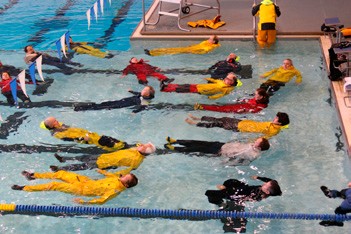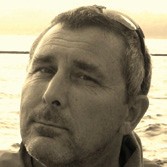By Joe Cooper
 Late February found me flying west to visit my mates in the Marin Marine Mafia in San Francisco, the nominal reason being to share the celebrations of one of our number in his 85th year. I also saw some of the other blokes and girls, went for a sail on SF Bay, introduced one of the former Prout sailors, now at university out there, to said mafia, and generally kicked back in the warm sun pouring in through the south windows of the hillside aerie in Mill Valley owned by my host, the birthday boy.
Late February found me flying west to visit my mates in the Marin Marine Mafia in San Francisco, the nominal reason being to share the celebrations of one of our number in his 85th year. I also saw some of the other blokes and girls, went for a sail on SF Bay, introduced one of the former Prout sailors, now at university out there, to said mafia, and generally kicked back in the warm sun pouring in through the south windows of the hillside aerie in Mill Valley owned by my host, the birthday boy.
Every sailor contemplating an offshore passage should attend a safety at sea seminar…and make sure your electronic rescue beacons are properly registered. © Spectrum Photo/Fran Grenon
One of the many wonderful aspects of such a visit are the evenings around the fire radiating from the center of the loft apartment above Commodore’s house, especially if there are readings of A.B. ‘Banjo’ Patterson. Banjo Patterson was a writer, lawyer, soldier journalist and notably, poet, to the fledgling Australia in the mid-19th to mid-20th century and in particular the author of the words to Waltzing Matilda and the iconic Aussie poem The Man from Snowy River. Another favorite is Clancy of the Overflow, a tale contrasting the life of a drover on the plains moving his herd across the sunny outback with that of an office worker chafed by the heat in the dusty, dirty city and the grime and stress associated with same.
And the bush hath friends to meet him, and their kindly voices greet him
In the murmur of the breezes and the river on its bars,
And he sees the vision splendid of the sunlit plains extended,
And at night the wond’rous glory of the everlasting stars.
Clancy of the Overflow, A.B. ‘Banjo’ Paterson, found on poemhunter.com
Scratch a sailor and you need not go too many microns below the sunscreen to find a dreamer, not too dissimilar to Clancy. To command your own vessel, on a voyage on the ocean, ideally to a distant port, especially if said port has white sandy shores, balmy breezes and waving palm trees (America’s Cup cats optional) must be in the DNA of those who come to sailing.
On the east of the U.S., the vision splendid many think of is a passage, not to India, but Bermuda. From Newport, Marion, Annapolis and Charleston, the dream is about 650 miles give or take a wave or three, on the other side of the Gulf Stream as though placed there solely to offer refuge to our seagoing Drover. Bermuda also doubles as a steady, dry place to taste the nectar of the gods, that legendary thirst quencher of the Bermuda-bound mariner, the Dark ‘n’ Stormy. Sailors being romantic, social animals like few things other than a starlit evening and a party at the other end of the passage and this latter activity probably goes a long way to explain why there are half a dozen races or rallies to one small coral and sand island in the west of the North Atlantic.
So it was that on one seriously cold Saturday in March I found myself seated, with perhaps 250 other dreamy drovers, in an auditorium at the University of Massachusetts for a Safety at Sea seminar. A speaker’s panel of the Usual Suspects shared something like 200 years of accumulated sailing experience.
Will Keene from Edson put some real meat on the issues of steering systems and their care and feeding, and in particular some hair-curling statistics on the rate of water ingress based on hole diameter and distance below the waterline. For an eye opener on why those little wooden plugs are a good idea, review this information on the Edson website.
Captain Henry Marx, President of Landfall and the senior ranking member at these seminars, was entertaining and informative with his Borscht Belt sardonic view of safety littered with personal anecdotes of just the right length and information.
Another veteran of the Seminar Tour was Bill Biewenga discussing heavy-weather sailing, a topic he is eminently qualified to speak on. Bill has four Whitbread races under his slickers, a couple of records with Rich Wilson, 40-plus Transatlantic passages – a number rivaling those of the top French solo sailors – and the personality to deliver information that gets your attention and shows you how to not get into some of the situations his slides represent.
One speaker I was unfamiliar with but would recommend hearing was Dr. Michael Jacobs, on health and in particular seasickness. Jacobs discussed some of the physics, the science, behind seasickness and how to either avoid or manage the mariner’s malady.
Yet another interesting speaker was Newport local Chris McNally, who discussed the intricacies of today’s offshore communication landscape. Of particular interest to the slightly Luddite me was information covering the proliferation of electronic gizmos with bright colors, blinking lights and acronyms worthy of the best of government bureaucracies.
The pull of your own landfall on that balmy, palmy island is strong, but for some, 650 miles is a voyage best taken after a warm-up passage of lesser distance. For those sailors the Marblehead to Halifax race at about 350 miles fits the bill almost perfectly, the downside being you sail across the chilly and often foggy Gulf of Maine, rather than the indigo blue warmth of the Gulf of Stream.
Forewarned is forearmed and for the Halifax division, meteo man Ken McKinley discussed Basic Weather and then zeroed into the elements most likely to confound sailors wishing to find Halifax and not the Bay of Fundy.
The moderator for this Halifax breakout session was Carl Lessard, yet another longtime sailor with about a 20-kilo bag of skills and experience across the spectrum of maritime activities and whose day job is as yacht (insurance) risk consultant. At the conclusion of this session, Carl showed a documentary on the ‘incident’ generally referred to as the Rambler capsize. If ever there was an episode to make you think about the preparation, planning, procedures and training one ought to consider prior to leaving the marina, this is it.
The 12-minute video covered the capsize from several perspectives. There is footage taken by one of the crew on the upside-down hull of the boat. Considering the circumstances, this real-time, man-in-the-street footage showed a remarkably calm and cool crew, as befits a well-trained team, professional or otherwise. There is commentary as the stunned, wet and cold sailors watch their fellow competitors 500 yards away sail past, oblivious to the upturned boat. The movie includes helicopter and Royal National Lifeboat Institution footage of spotting the boat and then some time later finding the cluster of five of the crew including owner George David and his girlfriend, who were washed off and away from the boat. At one point there is a voiceover from Wendy, David’s then girlfriend, now wife, recounting how she felt herself battling her declining will and health. She describes rasping breath, sounding like a gurgling, and battling the feeling that it would be just so easy to close her eyes and let go. This voiceover was across footage of this cluster being found and Wendy being dragged aboard the dive boat, and laying wet on the deck like a just-landed fish. They were found through slick work by the Irish Coast Guard, using models of the tide set and drift in the area.
One of the initial difficulties the various rescue authorities experienced was that the contact information for the EPIRB and the PLBs was apparently an office in New York City that was closed at the time of the incident, sunset in the Irish Sea. Much better to make sure the EPIRB is correctly registered.
Several years ago, during a Cooper Household spring cleanup we delivered my then 25-year-old EPIRB to an Eco-Waste cleanup day at First Beach in Newport. Sometime later that morning, I got a call from Jill (Mrs. Cooper) telling me I needed to call a USCG number in Boston…apparently the beacon had gone off. It had. The registration info was for our former digs in Manhattan. The Rescue Coordination Center guys had the location, adjacent to First Beach, and some basic info, so they called the Middletown Police and asked for any Joe Coopers and especially any with a boat connection. This they did and it led Middletown Police to our house and a surprised wife. I called the number. It was answered on the second ring by a man who identified himself as Petty Officer______, and I wish I remembered his name. I told him promptly and simply who I was, why I was calling and that it was a false alarm. He said, “Hang on a sec.” He put me on hold for about 10 seconds and came back on the line, at which time I fessed up to what had happened. Frankly, I was expecting something like a reading of the Riot Act and possible big money fines. The officer could not have been more gracious and understanding about the circumstances and expressed his, I am certain, heartfelt happiness it was a false alarm. In sum:
I had a quarter-century-old EPIRB manufactured by a now out of business company, that was accidently turned on in a dumpster and still showed up on the RCC screens. Walking back the timeline with Jill, I reckoned it was 20 minutes from the receipt of the alarm in Boston to the time the police office arrived at our house. Remember all this as you walk out of Landfall with your new EPIRB. Filling out forms is something Clancy’s office-bound mate dislikes, but in the case of forms for this kind of activity, remember the old gag: ‘The job’s not finished ‘til the paperwork’s done.’
 Australian born, Joe ‘Coop’ Cooper stayed in the US after the 1980 America’s Cup where he was the boat captain and sailed as Grinder/Sewer-man on Australia. His whole career has focused on sailing, especially the short-handed aspects of it. He lives in Middletown, RI where he coaches, consults and writes on his blog, joecoopersailing.com, when not paying attention to his wife, teenage son, dog, two cats and several, mainly small, boats.
Australian born, Joe ‘Coop’ Cooper stayed in the US after the 1980 America’s Cup where he was the boat captain and sailed as Grinder/Sewer-man on Australia. His whole career has focused on sailing, especially the short-handed aspects of it. He lives in Middletown, RI where he coaches, consults and writes on his blog, joecoopersailing.com, when not paying attention to his wife, teenage son, dog, two cats and several, mainly small, boats.



